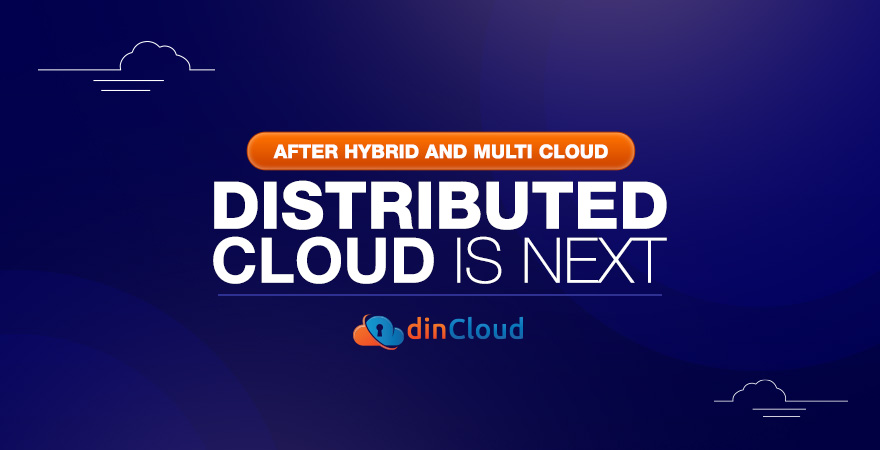Innovation and evolution have been the hallmarks of the cloud computing industry. Over the past few years, cloud solutions have become mainstream for organizations belonging to a wide range of industries and sizes.

As the influence of cloud powered solutions grows, so do the various iterations of the cloud that can be applied to a lot of use cases. When we talk of cloud solutions, there are many forms, which we will touch briefly with focus on a new concept, “distributed cloud”.
Also Read: Understanding Cloud Computing Models – IaaS, SaaS and PaaS
Public Cloud
In the case of public Cloud Service Providers (CSP) like dinCloud, the deploying entity will most likely fulfill its entire cloud needs from a single service provider. The public cloud model is highly suitable if you have physically dispersed locations or operations.
Another element that makes the public cloud stand out from the other models is cost effectiveness. It not only results in cost cutting, but also delivers instant scalability as your organizational needs change over time.
Hybrid Cloud
This is perhaps the “sweetest spot” that more and more deploying entities have started to feel comfortable with. In this concept, the cloud deploying entity does not fully engage a single public cloud provider (CSP).
Instead, some core processes are managed in house, while the remaining workloads are shifted to a public cloud service provider (CSP) like dinCloud. This option ensures cost savings due to the public cloud, while also maintaining the best control over data.
Also Read: List of Top VPS Providers for the Year 2020
Multi Cloud
In a multi cloud model, the deploying entity will not rely on a single cloud service provider. Instead, the multi cloud is a model that focuses solely on the plus points of each cloud provider and thus results in a well performing system.
However, there is a catch to it, which is the high level of complexity associated with such solutions. Due to the complexity associated with multi cloud environments, the intended benefits often become overshadowed.
Also Read: Understanding Cloud Computing Models – IaaS, SaaS and PaaS
A New Concept – The Distributed Cloud
The concept of a distributed cloud is relatively new but in theory, this deployment model can deliver a lot of benefits as compared to traditional cloud environments. By now, you must be familiar with the concept of edge computing.
In edge computing, we de-centralize data collection and processing at the most localized level, thus saving both time and computing resources. To better understand the distributed cloud, you should compare it with the concept of edge computing.
We are well aware that cloud computing hardware is prohibitively expensive. Although leading Cloud Service Providers (CSP) like dinCloud maintain a large footprint of data centers, the physical distance tends to deteriorate user experience due to latency.
Also Read: What Role Does Artificial Intelligence (AI) Have in Cloud Computing?
Optimal User Experience with Distributed Cloud
The distributed cloud model relies on the same concept of having powerful data centers, buy at a much localized level when it comes to their physical location. To distribute the high costs of such data centers, a number of organizations will share these resources.
So, with a distributed cloud, organizations will be able to enjoy the scalability and security of public cloud, while still enjoying the performance levels delivered by an exclusive private cloud environment or an on-premise data center.
Also Read: dinCloud’s HyperConverged Infrastructure Enables High Performance Desktop-as-a-Service (DaaS)
Ease of Meeting Compliance Standards
Now, we are rapidly moving towards stringent data management regulations. Most such regulations impose restrictions on the physical location of data, due to obvious jurisdictional complications.
Also Read: How to Attain Network Security in the Cloud & Beyond?
The distributed cloud is all set to resolve such compliance related bottlenecks as organizations will be able to store data at a much localized level in terms of physical location. We should see an even higher rate of cloud adoption with this model.
Conclusion
When it comes to a distributed cloud, we are still in the early days of this technology. However, the concept is so practical and simple that organizations that previously hesitated to migrate to the cloud should find it a much more plausible option.
As soon as distributed cloud environments find a foothold in the tech world, we should expect a large network of smaller data centers to spur up across the globe. This is likely to further take cloud user experience to a whole new level.
Contact dinCloud to learn more about our wide range of cloud services that are both robust and secure.


